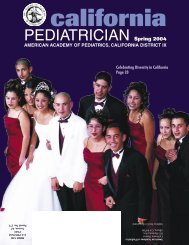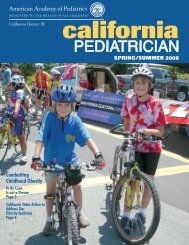PEDIATRICIAN Spring 2003 - AAP-CA
PEDIATRICIAN Spring 2003 - AAP-CA
PEDIATRICIAN Spring 2003 - AAP-CA
You also want an ePaper? Increase the reach of your titles
YUMPU automatically turns print PDFs into web optimized ePapers that Google loves.
SED — California Region<br />
Leonard Kutnik, M.D.<br />
California Surgeon<br />
General Needed to Protect<br />
Californians<br />
The Surgeon General’s Office reports<br />
that one in ten children and adolescents<br />
suffer from a mental health<br />
illness (1), but only one in five of these children<br />
receive specialty mental health services.<br />
Unfortunately, this rate of treatment is not<br />
being achieved in the State’s health insurance<br />
program for children, the Healthy Families<br />
Program. Only one-half of one percent of<br />
enrolled children were referred to a county<br />
mental health department for evaluation and<br />
treatment of a Serious Emotional Disturbance<br />
(SED). Primary care providers (including<br />
pediatricians) are ideally positioned at the<br />
frontline to identify HFP children with mental<br />
health problems. Therefore, greater assistance<br />
is needed from primary care providers (PCPs)<br />
to refer children who present signs and symptoms<br />
of SED to county mental health programs<br />
for evaluation and treatment.<br />
The Healthy Families Program is a state<br />
and federally funded insurance program that<br />
provides health care to low-income children<br />
up to age 19 who do not qualify for Medi-Cal<br />
and do not have private health insurance. The<br />
HFP provides comprehensive mental health<br />
services through participating health plans<br />
and local county mental health departments.<br />
Basic mental health services are provided<br />
by the participating health plans. Evaluation<br />
and treatment of SED are provided by county<br />
mental health departments. Serious emotional<br />
disturbance of a child is defined in the California<br />
Welfare and Institutions Code, Section<br />
5600.3(a)(2) as a mental disorder as identified<br />
in the most recent edition of the Diagnostic and<br />
Statistical Manual of Mental Disorders (other<br />
than a primary substance use disorder or developmental<br />
disorder) which results in behavior<br />
inappropriate to the child’s age according to<br />
expected developmental norms. SED treatment<br />
services provided by county mental<br />
health departments include outpatient services,<br />
inpatient services and prescription drugs.<br />
Most children enrolled in the HFP are<br />
members of health plans that require a primary<br />
care provider (PCP). Because of the<br />
large number of children who are affiliated<br />
with a PCP, the PCP plays a crucial role in<br />
the early detection of mental health problems<br />
and in improving HFP children’s access to<br />
SED services. HFP data indicate that in 2000,<br />
approximately 57% of children enrolled in<br />
the program for 12 consecutive months saw<br />
a PCP. Reports show that most families, and<br />
to a higher degree, ethnic minority families,<br />
are more likely to seek help from primary<br />
care providers as opposed to specialty care<br />
providers. (2) Given the large number (80%)<br />
of HFP subscribers who belong to an ethnic<br />
minority group, these reports further validate<br />
the importance of the PCP in detecting mental<br />
health problems.<br />
PCPs can receive assistance from participating<br />
health plans in referring children<br />
to county mental health departments for SED<br />
The Healthy Families Program provides comprehensive mental<br />
health services through participating health plans and local county<br />
mental health departments.<br />
treatment. The health plans use a variety of<br />
methods to assist physicians in serving HFP<br />
subscribers and to communicate information<br />
about the HFP benefits. Examples of these<br />
methods include periodic newsletters and<br />
bulletins, quick reference guides, periodic luncheon<br />
meetings, electronic mail and website<br />
access. The methods used are specific to individual<br />
health plans. Physicians should call the<br />
health plans they are affiliated with for more<br />
information.<br />
In addition to the assistance the health<br />
plans provide, the California Institute of<br />
Mental Health (CIMH), with funding from<br />
the David and Lucile Packard Foundation, has<br />
developed a provider manual. This manual,<br />
Healthy Families Resources Binder, was<br />
developed through collaboration among counties,<br />
health plans, State staff and CIMH. The<br />
binder provides information about the HFP and<br />
the SED referral process that is practical and<br />
easily accessible. Specific information provided<br />
includes health plan and county mental<br />
health liaison phone numbers, flow charts for<br />
CONTINUED ON PAGE 31<br />
On April 10, <strong>2003</strong>, the Little Hoover Commission<br />
urged policy-makers to fortify California’s<br />
public health system so it can better detect and<br />
respond to a wide range of threats, from emerging<br />
diseases and hospital-acquired infections to<br />
bioterrorism.<br />
The Commission recommended the State<br />
develop expert leadership, establish standards,<br />
increase training, improve communications,<br />
and strengthen laboratory and other capacities<br />
essential to the public health infrastructure.<br />
The report — To Protect and Prevent:<br />
Rebuilding California’s Public Health System<br />
— was issued after 10 months of public meetings,<br />
interviews, and deliberations, during<br />
which an array of experts identified specific<br />
weaknesses and practical improvements to<br />
a system that has gradually eroded over the<br />
last three decades. The Commission initiated<br />
the project after the terrorist attacks of 2001<br />
revealed that the traditional capacities of the<br />
public health system to detect and respond<br />
to epidemics and other disasters had been<br />
neglected as a public attention focused on individual<br />
health care. The Commission concluded<br />
that the improvements are needed to protect all<br />
California from a range of health risks.<br />
The Commission recommended that the<br />
core public health functions be consolidated<br />
into a single state department and that the State<br />
re-establish a volunteer public health board<br />
to provide expert involvement and public<br />
accountability to the government’s efforts.<br />
The State needs to strategically develop<br />
and employ technologies and trained professionals<br />
to make sure the system detects and<br />
assesses health threats, develops the most<br />
effective responses, and communicates with<br />
health care providers and the public. Together,<br />
the reforms would redefine public health as the<br />
third component of California’s public safety<br />
triad — police, fire, and public health.<br />
A fortified public health system would<br />
reduce the risk to all Californians, ensuring<br />
capacities in times of emergency, and reducing<br />
demands on the overall health system.<br />
While the federal and state government<br />
have taken steps since September 11, 2001<br />
to repair the system, the fundamental and<br />
structural problems have not been adequately<br />
addressed in California.<br />
The Little Hoover Commission is a bipartisan<br />
and independent state agency charged<br />
with advising the Governor and Legislature on<br />
ways to improve the efficiency and effectiveness<br />
of state programs. The full Commission<br />
report is available on www.lhc.ca.gov.<br />
<strong>CA</strong>LIFORNIA <strong>PEDIATRICIAN</strong> — SPRING <strong>2003</strong>/ 29








